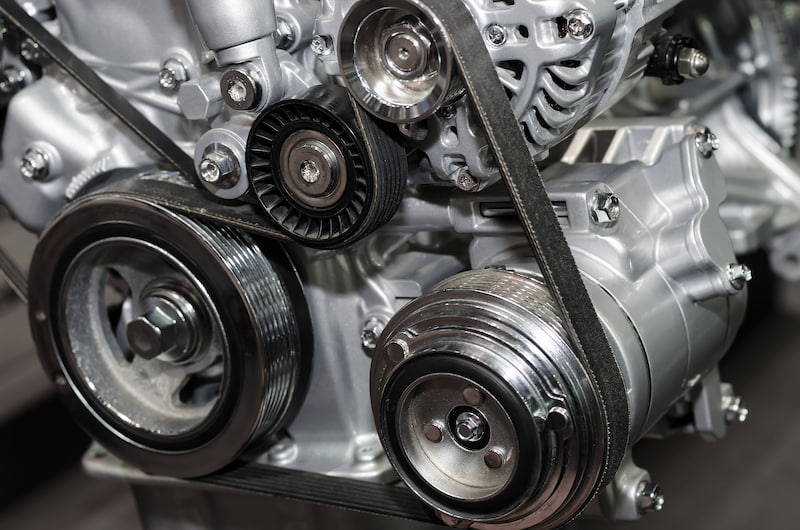A belt drive is one of the most popular types of power transmission methods besides gears, chain drives, shaft couplings and lead screws. The use of these highly efficient mechanical drives is increasing with every passing year.
Due to the many advances in belt technology, they are now able to meet high-power demands while being extremely safe, efficient and durable. In this article, we shall take a detailed look at the different types of modern belt drives and belt types.
What Is a Belt Drive?
A belt drive is a frictional drive that transmits power between two or more shafts using pulleys and an elastic belt. In most cases, it is powered by friction but it may also be a positive drive. It can operate at wide ranges of speed and power requirements. It is also highly efficient.
When it comes to cost, a belt drive is considerably cheaper than gear and chain drives. It costs less to install as well as maintain. Belt drive sheaves or pulleys undergo little wear compared to chain drive sprockets over extended periods of use.
Contrary to most chain and gear drives, a belt drive can handle some degree of misalignment. Correct alignment, however, increases service life. Excessive misalignment is responsible for issues such as improper belt tracking, uneven pulley wear, noisy operation and belt edge wear. The intensity of these issues is directly proportional to the belt’s width.
Belt tracking refers to the belt’s ability to be centrally located on the pulley and not shift to either side when in operation. Crowned pulleys can alleviate belt tracking issues.
It is also worth noting that a belt drive usually reduces shaft speed. For this reason, the driving pulley is usually smaller than the driven pulley. This provides a greater wrap angle on the driven pulley which is beneficial in friction-based drives. Designers may also use an idler pulley to increase the wrap angle and to maintain the recommended belt tension.
Belt Tension and Slack
The belt is subjected to tension when the driving pulley pulls it. This belt tension, in addition to the static belt tension, is responsible for the transfer of mechanical force. High belt tension prevents heat buildup, slippage and alignment problems as there is little to no relative motion between the belt and the pulleys.
On the other side, the driving pulley pushes the belt away towards the driven pulley. This causes slacking of the belt. Thus, a belt drive sets up fluctuating loads in the belt. If these loads are not considered in the design process, premature belt failure can occur. Fatigue is responsible for more belt failures than any other issue.
It is easy to identify the slack side from the side under tension. Whichever side of the belt approaches the driving pulley is under tension. The other side is the slack side.
Types of Belt Drives
As discussed above, belt drives today are capable of handling a wide range of speeds and power transmission needs. This has prompted further R&D, providing us with an array of different belt drive designs. All engineers should be familiar with the different types to facilitate an informed choice when selecting a belt drive for their application.
We can classify belt drives into seven main types, these are:
- Open belt drive
- Closed or crossed belt drive
- Fast and loose cone pulley
- Stepped cone pulley
- Jockey pulley drive
- Quarter turn belt drive
- Compound belt drive
Open belt drive
This is the simplest type of belt drive where two or more pulleys are connected with a belt wrapped around them. When power is supplied to the driving shaft, it rotates the driving pulley. The belt moves with it and rotates one or more driven pulleys.
In an open belt drive, both pulleys rotate in the same direction. With a horizontal pulley arrangement, the tight side of the belt is at the bottom and the slack side is at the top to increase the belt’s angle of contact with the pulleys.
Cross belt drive
This type of drive is used when two pulleys need to rotate in opposite directions or require a greater wrap angle for power transfer. In a crossed belt drive (aka twisted or closed belt drive), after passing over the top of the driven pulley, the belt contacts the driving pulley from the bottom. Thus, the belt’s shape resembles the number 8.
Between the two pulleys, the belt comes in contact with itself and the rubbing causes the belt to wear off. This can be mitigated by placing pulleys at the maximum allowed distance and running the system at slow speeds.
The crossed belt drive can transfer greater power for the same pulley dimensions and centre distance as the contact angle is higher. However, a longer belt is required as is evident by its crossed positioning.
Stepped cone pulley
This type of belt drive uses a driven pulley with multiple diameters. As the pulley resembles a stepped cone, it is known as a stepped cone pulley drive.
This drive is used when the driven shaft needs to be rotated at different speeds. Speed of the driven shaft can be increased or decreased by shifting the belt to a smaller or larger diameter step on the pulley respectively.
Common applications for this type of drive are lathes and drilling machines. A stepped cone pulley enables to use the same drive motor to obtain different output speeds.
Fast and loose cone pulley
As the name suggests, this drive consists of two pulleys – one fast and the other loose. Both of these pulleys are mounted on the driven shaft.
The fast pulley is keyed to the driven shaft so it rotates at the same speed as the shaft. The loose pulley is mounted without a key so it rotates freely relative to the shaft. This pulley is incapable of power transmission.
To hold the loose pulley in its place, a gun-metal or cast-iron bushing with a collar on one end is used. This prevents any axial movement. The diameter of the loose pulley is smaller than the fast pulley’s to allow the belt some slack.
This drive permits the immediate start and stop of the driven shaft without changing the speed of the driving shaft. When power needs to be transferred, the belt is shifted from the loose pulley to the fast pulley and when it needs to be stopped, the belt shifts back to the loose pulley.
Fast and loose cone pulley drives find use in applications where one line shaft powers multiple driven shafts. Switching to the loose pulley stops power transmission without having to stop the driving shaft which may be powering other shafts at the same time.
Jockey pulley drive
The dimensions of the smaller pulley decide the maximum force that the belt drive system can transmit. But what if both pulleys are small? Smaller pulleys lead to a smaller contact area between the belt surface and the pulley. If the pulley diameter is too small for meaningful contact with the belt’s surface, the power transmission capacity reduces.
Alternately, if the pulleys are required to be really close to each other, the wrap angle around the smaller pulley is reduced. This limits its power transmission capacity.
The solution for the aforementioned cases is to use a jockey wheel or an idler pulley. In mechanical systems, a jockey wheel refers to a machine element that steers or guides another element.
The idler pulley is placed on the slack side of the belt. They improve the belt drive’s performance as they reduce vibration by supporting the belt.
Idler pulleys can increase the wrap angle for smaller pulleys, ultimately increasing the surface area between the drive belt and the pulley.
Quarter turn belt drive
Most belt drives can only work with parallel shafts. But this may not always be the case. In situations where rotating shafts are at the right angles, we can use quarter turn belt drives.
Quarter turn belt drives (aka right angle belt drives) have a belt that goes around two perpendicular shafts after making a quarter turn. For the belt to stay in place, the pulley’s width must be at least 40% wider than the belt’s cross-section.
In some cases, guides or idler pulleys are used to promote better belt tracking and prevent slip off.
Compound belt drive
A common application for belt drives is to reduce shaft speed. This is part of the reason why most belt drives transfer motion from a smaller pulley to a larger pulley. But sometimes the speed ratio achieved from one set of pulleys may not be enough. In such cases, the designers can opt for compound belt drives as they allow for have higher speed ratios to be achieved.
A compound belt drive consists of more than two shafts with multiple pulleys keyed to at least one of the shafts. The driving pulley transfers power from one shaft to another through multiple shafts.
This setup improves the speed ratio without requiring a larger driven pulley or too much extra space.
- Personal account manager
- Quality assurance
- Payment terms for companies
- On-time delivery by Fractory
Types of Belts
As with belt drives, belt designs have been specialized for various applications too. Each of them offers various benefits over others in specific situations. We will take a look at five of the most popular types of belts used in belt drives today. These five types are:
- Round belt
- Flat belt
- V belt
- Toothed belt
- Link belt
Round belt
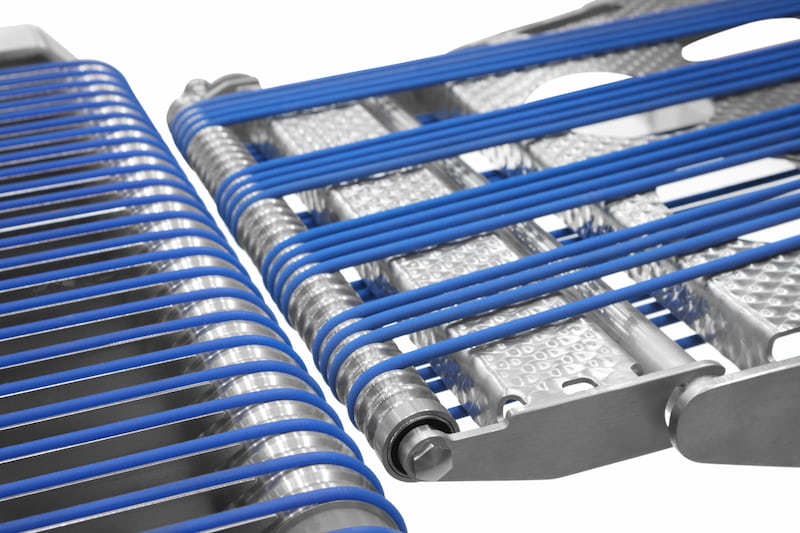 Round belts have a circular cross-section and fit into U or V-shaped grooves in a pulley. They are also known as endless drive, endless round and O ring type belts.
Round belts have a circular cross-section and fit into U or V-shaped grooves in a pulley. They are also known as endless drive, endless round and O ring type belts.
Round belts are used in motion control as well as power transmission applications. These belts find use in line shafts, industrial conveyors, packaging machinery, photocopiers, printers, etc.
In applications where belts are expected to twist and turn a lot, contacting multiple pulleys in the process, round belts are highly suitable. Due to their very nature, these belts can transmit power and provide friction from any part of their circular surface.
Some other beneficial features of round belts are:
- Available in different sizes, colours and textures
- No fraying
- Economical
- Strong and durable
- Easy to clean
- Fit various pulley shapes
- Non-marking
- Can be reinforced for greater strength
- Features such as abrasion and UV resistance can be improved on need
Flat belt
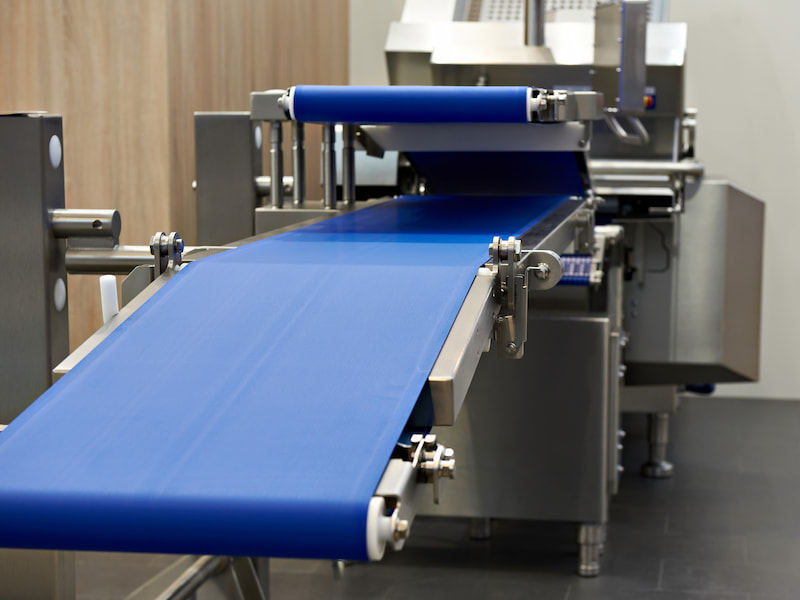
Flat belts are one of the most common types of industrial belts. These belts have a rectangular cross-section and rest on top of flat pulleys for operation. They transmit power from one or both sides depending on the design. Flat belts find use in many industrial machines such as compressors, separators, fans, belt conveyors, sawmills, water pumps and machine tools such as grinders.
A leather belt was originally used in flat belt applications. But over time, with the discovery of new materials such as rubber and synthetic polymers, the use of leather belts has somewhat diminished.
Flat belts work best with crowned or tapered pulleys.
Some excellent features of flat belts are:
- A flat belt can deliver high power at high belt speeds
- Low noise operation
- High efficiency (up to 98%)
- Small bending loss due to small bending cross-section
- High flexibility
- No need for grooves
- Long service life as they handle dust and dirt reasonably well
- Can be reinforced for greater strength
V belt
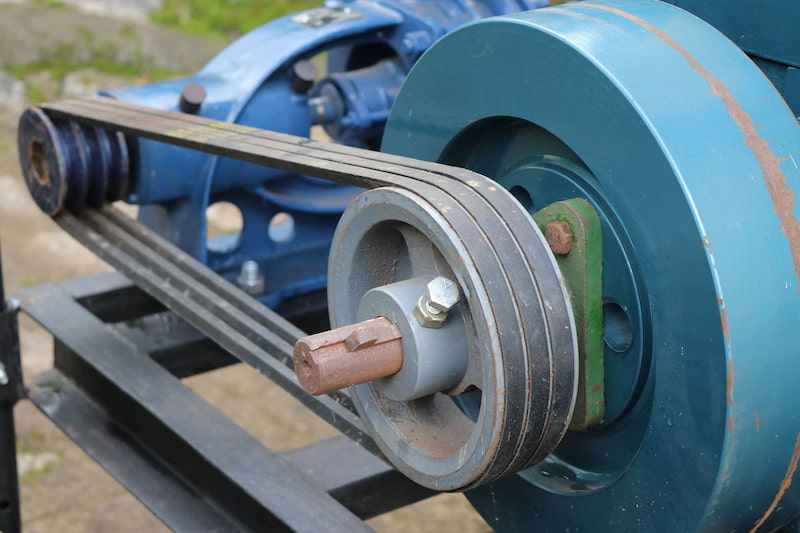 Flat belts are not suited for applications where the centre distance between pulleys is small. V belts have largely replaced them in such areas. In fact, V belts are the most common belt type in use today.
Flat belts are not suited for applications where the centre distance between pulleys is small. V belts have largely replaced them in such areas. In fact, V belts are the most common belt type in use today.
A V belt has a trapezoidal (V-shaped) cross-section that fits into a similar groove on pulleys and sheaves. As V belt drives have a larger contact area between the pulley and the belt section (bottom + 2 sides), they can transmit greater power for the same dimensions.
V belts find use in various machine tools such as lathes, drills, milling machines and power tools. They are also widely used in non-industrial applications.
For a more complete understanding of V belts, there are two special types that need further explanation. These are hex belts and kraftbands.
A hex belt is something that we would get if we glued together the top surface of two V belts. The result is a hexagonal-shaped belt that can wedge into pulleys from both sides. Another apt name for a hex belt is a double V belt. They are perfect for applications with one or more reverse bends.
Kraftbands are a special type of V belt that looks as if several V belts are connected side by side at their top edges. It can work as multiple belts in one by increasing the contact area for power transmission. Up to five V belts can connect to form a single kraftband.
Some important features of V belts are as follows:
- Available in a wide range of sizes, strengths, and materials
- High power transmission capacity at high belt speeds
- Low cost
- Easy installation
- Compact arrangement
- Can combine with multi-grooved pulleys for many operational advantages
- Lower efficiency than flat belts due to the wedging effect with pulleys.
Toothed belt
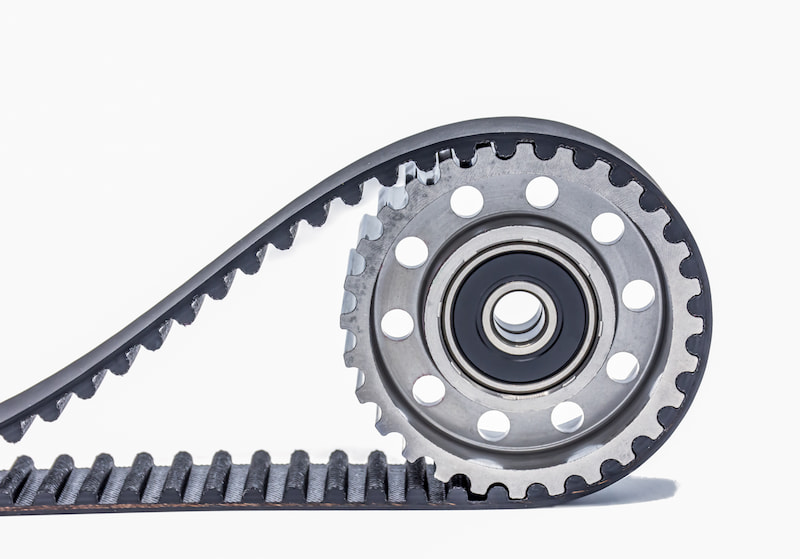 While flat, round and V belts are excellent at transferring motion, they have some limitations. For example, belt slip cannot be eliminated in any of them. In applications where having no slip is a requirement, we must use toothed belts.
While flat, round and V belts are excellent at transferring motion, they have some limitations. For example, belt slip cannot be eliminated in any of them. In applications where having no slip is a requirement, we must use toothed belts.
A toothed belt is a positive transfer belt that does not need friction for power transfer. It transfers force via teeth similar to chain or gear drives but with much lower noise levels and without the need for excessive lubrication.
The belts have teeth on the engaging side of the belt. These teeth fit into corresponding grooves machined onto the pulley. Toothed belts do not slip at all and are used in applications where maintaining accurate timing and position is critical. As a result, these belts are also known as timing belts or synchronous belts. They are commonly used in automobile and motorcycle engines to power and time camshafts.
Link belt
ARVE error: url: https://www.googleapis.com/youtube/v3/videos?part=snippet%2Cstatistics&id=QLkHa257vmw&key=AIzaSyAQ7WFzTAUrOX-FjsIrFS3JwZBFzgIvloc Status code 200 expected but was 403.
Link belt is a special belt type that consists of many individual links. These links can be attached and detached as needed to change the length of the belt. The links are typically made from polyurethane and reinforced by a multilayer woven polyester fabric.
Link belts offer features similar to endless belts and do not need special pulleys to function. They have the same power and speed ratings as similarly-sized endless belts. They are easy and fast to install as the machine does not need to be disassembled.
Link belts are costlier than other alternatives which may restrict their use in budget-conscious applications. However, they offer excellent vibration dampening features and they can resist environmental factors much better than rubber belts.
Belt Drive Selection
To select the right belt for the right application, many factors must be considered. These factors help us determine the belt and pulley characteristics required for belt drive design. Some of these important factors are:
- Power transmission requirements
- Shaft separation
- Service environment
- Space constraints
- Type of driven load
- Speed ratio
Power transmission requirements
Belts can transfer power in a wide range of applications. We need accurate data with the appropriate safety factor to determine the type of belt that is best suited for the application.
Shaft separation
Every belt drive has an optimal distance at which it performs best. A small distance between the shafts would suggest the use of jockey pulley drive while long distances would permit an open belt drive for cost savings.
Service environment
Service environment factors such as oil, moisture, high temperatures, dust, snow etc. can affect many parameters such as belt wear, belt life, material, function and slip. The selection of belt drive must focus on the service environment that the belt must endure for a satisfactory wear life.
Space constraints
Limited available space can direct us towards more compact assemblies. Compact setups with hex belts or compound drives can significantly reduce the amount of space a belt drive requires.
Type of driven load
The loads driven by belts can be jerky, shock-prone or reversible. The selection process must opt for belts and pulleys that can manage such loads to ensure compatibility.
Speed ratio
Most belt drives have speed ratio greater than one which means that the driven pulley is larger than the driving pulley. In order to achieve this speed ratio, the designers can either increase the size of the driven pulley or reduce the size of the driving pulley.
But there are certain limitations in both. Increasing the size of the driven pulley drives up the costs and space requirements. Decreasing the size of the driving pulley can only be done to a certain extent as the belt must be capable of bending and wrapping around the driving pulley. Small pulleys increase the elongation of the belt’s outer fibres, exacerbating belt wear and life expectancy.
To add to this, both pulleys cannot be too small as that would result in a high belt velocity which is detrimental to belt life as well.
Advantages
- Belt drives are quite affordable thanks to low component cost and high efficiency
- They can transmit power over long distances, contrary to gears, couplings and lead screws
- Compared to chain drives, they operate smoother and more quietly
- They can absorb shock and vibrations
- Overload protection through the slipping of the belt
- Lightweight and relatively durable
- Low maintenance costs
Disadvantages
- Belt slippage can vary the velocity ratio
- They apply a heavy load on the bearings and shafts
- Finite speed range
- Short service life if not maintained well
- They need an idler pulley or some adjustment of center distance to compensate for belt stretching and wear
Conclusion
Belt drives are very common in the industry today. They are used in light as well as heavy-duty applications in many different configurations.
Round and toothed belts can measure the slightest relative movement in applications such as motion control, encoders and precision manufacturing. Flat, V and timing belts are widely used as power transmission belts. They find extensive use as material handling equipment too.
Belt drives are preferred in these applications for their salient features such as low cost, low weight, reliability, flexibility, durability, easy installation and maintenance. Generally, they can also be fitted into tight spaces.
They do have certain drawbacks though. Often times the belts are not repairable and must be replaced. Their tension needs to be adjusted every now and then. And most belt materials are sensitive to the environment and chemicals such as oils and lubricants.
Thus, due consideration and attention must be paid when choosing a belt drive system that is as compatible as possible with the application at hand.


